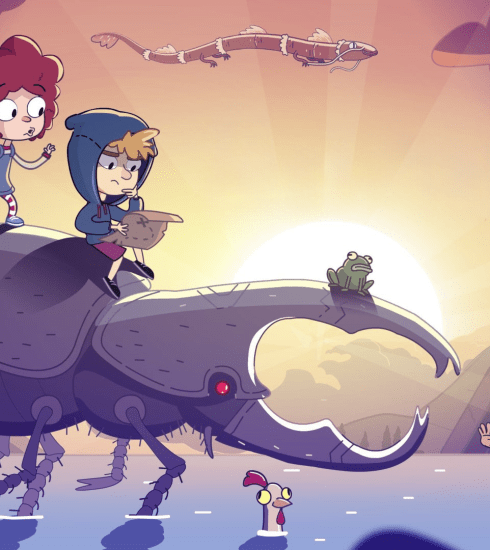#MaybeInMarch 2023: The Path review
Ever completed a game and not sure what it was you just played?
That pretty much sums up this year’s #MaybeInMarch selection for me in one line. For this annual event, gaming bloggers are encouraged to tackle the release that’s been waiting for them on their backlog the longest and share their thoughts on the experience.
As explained in my response for #LoveYourBacklog last month, I should have played Brütal Legend by Double Fine Productions for 2023. But as I like to stream my #MaybeInMarch game on Twitch and didn’t want to receive a copyright strike, it was better to pick something else. The choices were between The Cave also by Double Fine, Papo & Yo by Minority Media or The Path by Tale of Tales.
My first choice ended up being the last one. It was a purchase made in July 2013 after finding the book 1001 Video Games You Must Play Before You Die. I knew nothing about this 2009 release other than the information contained in the few paragraphs written by Chris Dahlen, and the thought of playing something relatively unknown for #MaybeInMarch charmed me.
My stream didn’t go according to plan though. The mechanics felt incredibly clunky and choosing to use a controller was a bad idea as it turned the protagonist’s movement into a slog. On top of this, the storyline was delivered in such a vague way that it was difficult to interpret what was happening on-screen. Taking our viewer’s comments on board, we made the decision to switch to our backup of Papo & Yo after 90 minutes and forgot about The Path that evening.

But when I woke up the next morning, it was still there in the back of my mind. The controls may have been horrible but there was something unique about the game which had inspired my curiosity. It gave me a feeling almost like the days when I first started blogging ten years ago. Around that time, there were so many releases which were considered creative, along with heated discussions on whether video games should be considered as art and if walking simulators were really games at all.
After pulling myself out of bed and leaving the rest of the Later Levels’ household to sleep, I turned on my PC and installed The Path once again. Using a mouse rather than a controller for my second attempt made the experience a little smoother even if a few quirks with the controls remained. The protagonists continued to get stuck on trees and it became tricky to manoeuvre when the camera angle changed in certain sections, but I’m pleased to report that I managed to reach the end of the title.
While the run button hadn’t worked on the controller the evening before, it now functioned on the mouse. The faster speed came at a price though. Whenever I triggered it, the camera would lift itself to a position among the branches of the trees so I couldn’t always see the girl I was controlling through the woods. I got the feeling this was a deliberate choice rather than design flaw. The Path is full of metaphors, perhaps this one being a reference to the way ahead being unclear if you’re moving too fast.
While those allegories make the game intriguing and open to interpretation, they increase the risk of the player not understanding what’s going on. I’m not ashamed to admit I’m still confused after having completed it and am sure there’s an underlying narrative I haven’t fully grasped. The only thing I’m certain of is that the objective to control each of the six female protagonists to Grandmother’s house is obviously inspired by the fairy-tale of Little Red Riding Hood.
A message telling you to stay on the path is presented at the beginning of each chapter, but you’ll receive a ‘failed’ message if you behave. You’re meant to break the rules and go wandering off into the woods. There are 144 flower-coins to collect and various objects which will trigger memories, but the girls also have their own specific wolf to face. These take on a different form for each of the protagonists and range from a will-o’-the-wisp for Rose to a piano teacher for Scarlet.

The screen blacks out after a girl’s encounter and then shows them lying on the ground outside Grandmother’s gates in the rain. Instead of happily walking forward to enter the house, they now move even more slowly with their bowed heads and hunched shoulders speaking of defeat. It’s obvious something massive has happened to change them, but it’s hard to say exactly what this is as nothing is explicitly explained in The Path. The endings to the protagonist’s chapters don’t make things any clearer.
It’s worth pointing out that despite the lack of clarity, some dark themes are covered in this game – at least, that’s the impression I got from the small things I was able to understand from playing it. There’s no graphic imagery and nothing gruesome is shown during the gameplay, but it’s impossible to shake the lingering feeling that each of the girls has met a horrific end. Subjects such as violence and murder are hinted at and make this ‘short horror’ one which isn’t for everybody.
However, the sources I found during internet research completed after finishing the game don’t always agree with this. The Wikipedia page states: “The Wolf is the antagonist in the game and takes on a different form for each girl. The forms represent tribulations that are associated with the stages of childhood and adolescence.” A post on the Lady Geek Girl and Friends blog from June 2014 refers to older gameplay videos, saying: “Most agree Ginger’s ending is about puberty, and Carmen’s is about rape.”
An interview with the developers published on the DarkZero site in April 2009 quoted them as saying: “The six girls represent different stages in the process of a girl growing up, which is one of the main themes of Little Red Riding Hood… The process of growing up remains a very difficult and painful one, which makes it rather hard to really be envious of youth. The Path offers players a chance to revisit that time of insecurity, of not being in control of your own thoughts and feelings and an opportunity to compare these thoughts and emotions to their own, current state of mind and heart.”
This is backed up by a post-mortem report on the Game Developer website from July 2010: “Some say blindly that the game is ‘about rape’. And while that could be one of the interpretations – and I understand it – for me, those black-out moments after meeting her wolf are the moments of realisation. Those are the times when a girl grows. And what happens in Grandmother’s house is not a murder but a shedding of childhood and an initiation to womanhood. Each girl one step closer to her fate.”

What I’ve found fascinating about this release is how all the interpretations put forward are so different. At one end of the path (pun very much intended) we have the developers, who viewed their project as a story about growing up and the shedding of innocence. Then there are the critics, who like to discuss the artistic representation of adolescence using overly long and flowery words. And at the other end there are the players, who are more likely to focus on the game’s darker themes and horror elements.
As for me, I still have no idea what to make of it. But I’m glad I made the effort to return to The Path after my #MaybeInMarch stream because it was such a unique and intriguing experience. I guess that’s the beauty of this annual event: you never know where the road is going to take you and what you’ll end up playing.







kaytalksgames
1 year agoI remember wanting to play this way back when it first came out. Hearing your perspective on how ambiguous the themes are makes me curious to finally try it out.
Kim
1 year agoIt’s worth giving it a try just for the experience, because it’s so unique. I’d love to hear your thoughts once you’ve played it. 🙂